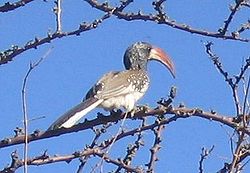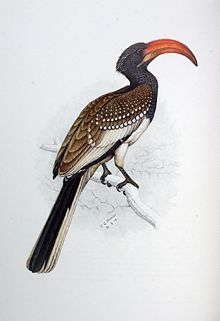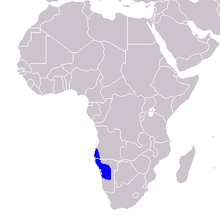- Monteiro's Hornbill
-
Monteiro's Hornbill 
Conservation status Scientific classification Kingdom: Animalia Phylum: Chordata Class: Aves Order: Coraciiformes Family: Bucerotidae Subfamily: Bucerotinae Genus: Tockus Species: T. monteiri Binomial name Tockus monteiri
Hartlaub, 1865The Monteiro's Hornbill, Tockus monteiri, is an African Hornbill. It is a medium sized bird, with a length between 54 to 58 cm, characterized by a white belly, black back, with white spots on the wings and secondary flight feathers coloured white. The outer feathers of the long tail are also white.
Females are smaller than males and can be recognized by turquoise facial skin. The eyes are black and the beak is red. Unlike other members of the family, which are omnivorous, the Monteiro's hornbill feeds exclusively on insects and other small arthropods. Its habitat is the savannah and dry thorn fields of NW Namibia.
In springtime, Monteiro's hornbills migrate to the southern Windhoek region for nesting. Due to the arid environment, drinking is not a vital necessity for this species. They breed in the end of good rainy season, laying 3 to 5 white-greyish eggs, hatched after about 45 days. The nest is built in rocky faces or trees. The Monteiro's hornbill is a common endemic species of Namibia, with total population estimated on 340,000 individuals.
References
- BirdLife International (2004). Tockus monteiri. 2006. IUCN Red List of Threatened Species. IUCN 2006. www.iucnredlist.org. Retrieved on 6 May 2006. Database entry includes justification for why this species is of least concern
Categories:- IUCN Red List least concern species
- Tockus
- Hornbills
- Birds of Africa
- Birds of Namibia
- Animals described in 1865
Wikimedia Foundation. 2010.



